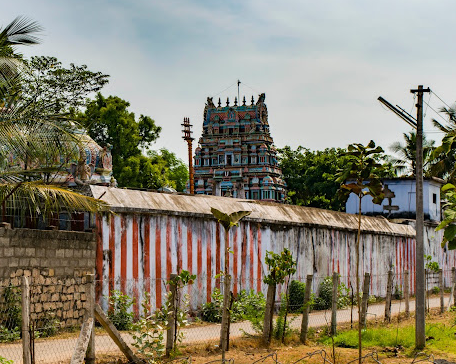- Sri Aandu Alakkum Ayan Perumal Temple near Kumbakonam is the 11th Divya desam which is one of the 108 Divya Desams that are dedicated to Lord Vishnu.
- Andalakkun ayyan temple here is one of the Vaishnava navagraha parihara sthalams around Kumbakonam.
- It is a Guru parihara sthalam.
- The original temple was built by the Chozha king Aditha Chozha.
- The temple received contributions from Vijayanagaras / Thanjavur Nayaks and Maratha Kings.
- The temple is being maintained by Ahobila mutt and Rajagopuram was constructed by Bombay Tanks and Vessels Ltd, Sri Ramanuja Ayyangar, with the effort of 44th pattam Jeeyar of Ahobila Mutt. Maha samprokshanam was conducted on 31st August 1973.
- To Commemorate 45th Jeer of Ahobila mutt Srimad Azhagiya Singar Sri Lakshmi Narasimha Divya Pathusevaka Sri Vantakopa Sri Narayana Theertha Maha Desika’s sathabhishekam, this temple’s Maha samprokshanam was conducted on 12th July 2006.
PURANIC SIGNIFICANCE 1:
- Actually in Tamil, “Pasu” means cow. Kaamadhenu which is known to be a Divine cow is said to be good to give all sorts of wealth.
- During Kurma Avatharam taken by Lord Vishnu, all sorts of good things come out of it, which is useful to the world.
- One of those things is Kaamadhenu, which is gifted to Indiran, the king of swargha Lokam.
- Pasu (Cow) = Aa + than + oor. “Aa” means cow.
- Since, the Lord gave Pratyaksham for Kaamadhenu, this sthalam is called as “Thiru Adhanoor”.
- Kamadhenu and Agni worshipped Maha Vishnu of this temple. Since Kamadhenu – ஆ..( celestial Cow, which can give whatever the food asked ) was over pride of her power and elder to Maha Lakshmi.
- Maha Vishnu asked her to measure her wealth through the marakkal. It was not filled.
- When Mahalakshmi dropped a leaf of Tulasi, the Marakkal filled and overflowed. Kamadhenu felt ashamed and did a penance on Maha Vishnu to forgive her. Satisfied with her penance, Maha Vishnu pardoned her.
- Hence this place was called Adhanur.
- This place is believed to be older than Srirangam, called Adi Rangeswaram, which is mentioned in Brahmanda Purana.
PURANIC SIGNIFICANCE 2:
- As per the legend, when Thirumangai Alwar was doing thirupani of Srirangam Temple, he was left with the shortage of money to pay the labourers.
- When he prayed to Maha Vishnu, in the form of asariri, Maha Vishnu asked Thirumangai Alwar to come to the banks of Kollidam to get the money.
- Next day, Thirumangai Alwar went to the Kollidam river bank.
- A merchant with a marakkal / measuring jar came and told that he was sent by Maha Vishnu.
- Thirumangai Alwar told the merchant that he needs money to pay the labourers.
- The merchant measured the sand and gave it to him and told that it will appear as Gold to those who are really working.
- When Thirumangai Alwar gave the sand to the labourers, most of them complained that he was giving only the sand and not the Gold.
- Thirumangai Alwar felt that he was cheated and chased the merchant.
PURANIC SIGNIFICANCE 3:
- Another legend is that God Sri Anjaneya on his way from Lanka to Ayodhya rested at this place for two days.
- Later Sri Rama also came and enquired whether his Bhakta Sri Anjeneya came and stayed here and also left his Paduka at this place.
- There is an idol of Sri Anjaneya called Veera Sudarshana Sri Anjaneya as well as two Padukas of Sri Rama at this temple.
- This Vaishnavite temple is the Navagraha Sthalam for Sri Guru Bhagawan.
- Another legend is that a daughter of a Kashmir king was possessed by a Brahma Rakshasa and so he came to this place with his family and was relieved.
PURANIC SIGNIFICANCE 4:
- In another legend, Suryan ( aadhavan ) worshipped Sri Saranathan of this temple, hence this place is called Adhanur.
- In another legend, this place is also called as Agni saba vimochana sthalam.
- Agani was affected by a saba for attending the yagna conducted by Brahma, without his consort Saraswati.
- Saraswati cursed Brahma and those who participated in the yagna.
- Agni came to this temple and worshipped Sri Saranathan and was relieved from the saba.
PURANIC SIGNIFICANCE 5:
- The lord who is supposed to be the Paramaathma, resides (Urayum) on all of the hearts, which is considered as the place of stay of him.
- He is seeing all the activities of Jeevatma by going in depth to call a cell.
- As the seva of this God, he holds off the leaf (Oolai Chuvadi) and a writing instrument, he calculates the good and bad activities of all the Jeevathmaas and based on the activities, he is ruling the Jeevathmaas.
- Because of this reason this Emperumal is called as “Aandu Alakkum Ayan”, as he keeps Marakkal, a measuring instrument which is used as the measuring tool for measuring the good and bad activities.
- His right hand is the hand which serves all the necessary things needed for the world (Padi alakkum Kai(hand)) and left hand for writing.
- The Sun which is rising above the Earth is one of the ways he sees the world.
- The rays of the sun are the Eye of God. All the things are happening only after his eyes are opened.
- He is not only serving for the Humans (Mankind) but also for the flowers, rivers, mountains, animals etc.
- By going in depth into their body as sun rays, he is taking them along their way.
- Not even a single cell and its activities can escape from the Sun's rays in this world.
- Because of this reason, this Kshethram is called as “Aadhavanulla Oor”, which is laterly called as “Adhanoor”.
- Aadhavan means sun and at the same time as the name implies, the pushkarani here is Soorya (Soorya means Sun in Tamil)pushkarani.
PURANIC SIGNIFICANCE 6:
- When Sage Brugu worshipped Perumal in the Milk Ocean, Mother Mahalakshmi presented the sage with a garland.
- The sage gave it to Indira who in turn placed it on the head of his elephant. The animal drew the garland and crushed it under its foot.
- Boiling in anger, the sage cursed Indira to be born a human on earth. Indira fell down to earth and rushed to Lord seeking relief.
- Mother Mahalakshmi assured Indira that she would be born the daughter of Sage Bruhu and he would be relieved of the curse when She weds Perumal then.
- Indira waited for the time. When the divine wedding took place, he was relieved.
- Lord Perumal granted darshan to him in His celebrated reclining posture.

